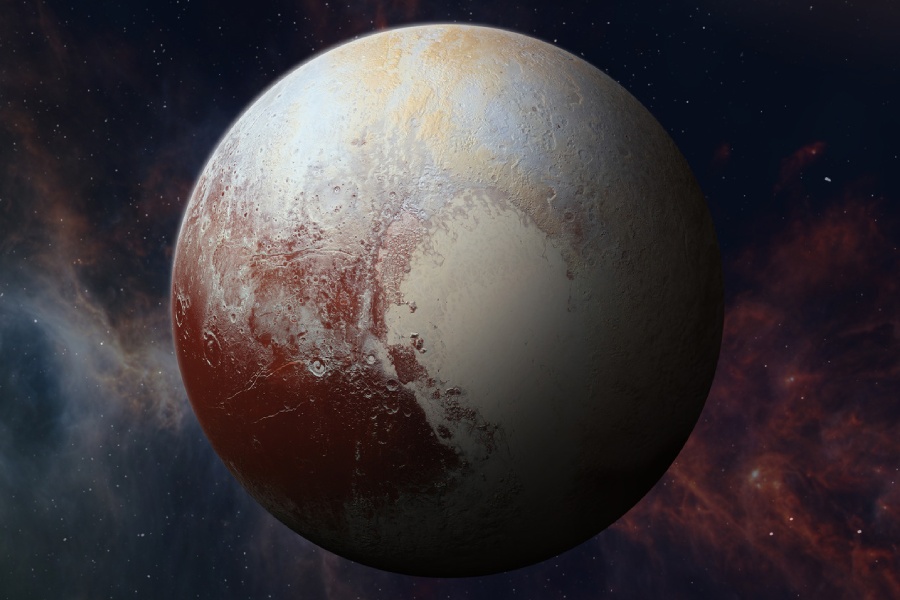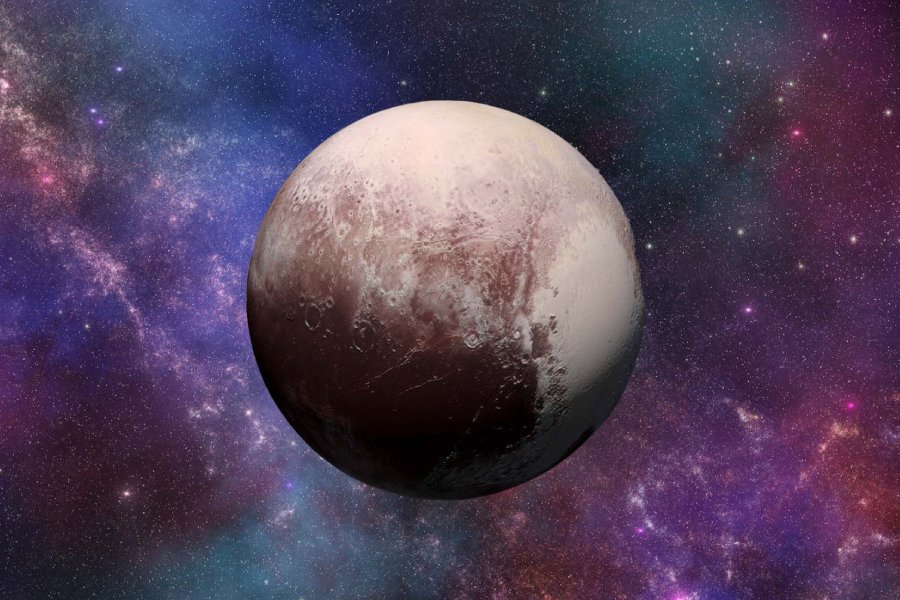Among the cosmic oddballs occupying the outer solar system, the diminutive world of Pluto stands out with its own set of bewildering traits. Ever since its controversial demotion from planetary status, Pluto characteristics and frozen environment have captivated astronomers seeking to unravel its mysteries.
What exactly makes the former ninth planet so unique, from its orbital behavior to surface features? In this article, we will explore the essential Pluto facts that set this icy dwarf apart while also linking it to the broader Kuiper belt.
Delving into Pluto’s eccentric orbital dynamics, perplexing rotational period, changing volatile-rich seasons, and enigmatic geologic formations reveals an intricate world shaped by confounding forces.
We will survey what makes Pluto extraordinary among its frigid Kuiper belt neighbors and how ongoing studies continue unveiling new aspects of this remote locale where impacts and cryovolcanism sculpt alien landscapes.
As the New Horizons spacecraft ventures deeper into Pluto’s realm, these Pluto characteristics emerge from the darkness, showcasing the remarkable diversity in our cosmic backyard.
Overview: Pluto Characteristics
What are the defining Pluto characteristics? Pluto, a dwarf planet, is smaller than Earth’s moon, featuring a surface with plains and mountains. Its eccentric orbit takes about 248 years, and it hosts a system of moons, notably Charon.
Pluto’s thin atmosphere undergoes seasonal changes, and despite its demotion in 2006, it remains a captivating celestial object on the solar system’s edge.

Some Unique Characteristics of Pluto
- Dwarf planet status – Pluto holds the distinction of being a dwarf planet, a classification that sparked debates and discussions within the astronomical community after its reclassification by the International Astronomical Union (IAU) in 2006.
- Size and comparative scale – Despite its small size, Pluto is unique for its scale. It is smaller than Earth’s moon, highlighting the diversity of sizes among celestial bodies in our solar system.
- Eccentric orbit – Pluto’s orbit is highly eccentric, meaning it deviates from a perfect circle. This eccentricity contributes to its varying distances from the Sun during its orbital journey.
- Inclined orbit – The inclination of Pluto’s orbit is distinctive, as it is tilted concerning the plane of the solar system. This inclination sets Pluto apart from the more aligned orbits of the eight traditional planets.
- Moons and “double dwarf planet” system – Pluto boasts a system of five moons, with Charon being the largest. The size relationship between Pluto and Charon creates a unique “double dwarf planet” dynamic, an uncommon feature in our solar system.
- Tombaugh Regio (heart-shaped region) – One of the most recognizable features on Pluto’s surface is Tombaugh Regio, a large heart-shaped region. The formation and significance of this feature continue to intrigue scientists.
- Thin atmosphere and seasonal changes – Pluto has a thin atmosphere composed of nitrogen, methane, and carbon monoxide. The dwarf planet undergoes seasonal changes, with its atmosphere freezing and collapsing during certain periods of its elliptical orbit.
- Icy composition and surface features – Pluto’s surface is composed of a mix of ice and rock. The diverse surface features, including frozen plains and mountains, contribute to its complex and dynamic geological history.
Physical Characteristics of Pluto
Size and distance from Sun
With a diameter of approximately 1,477 miles (2,377 kilometers), Pluto is relatively small, only about 18.5% the size of Earth. It orbits the Sun at an average distance of 3.7 billion miles (5.9 billion kilometers), about 39 times farther from the Sun than Earth. From this great distance, the Sun appears merely as an extremely bright star.
Surface composition
Pluto’s surface is composed predominantly of nitrogen ice with frozen methane and carbon monoxide ices. Exposed water ice is largely confined to scattered surface patches.
Stretches of Pluto’s surface also contain dark, reddish material likely formed from tholins – complex hydrocarbons produced when cosmic rays and solar ultraviolet light interact with methane in Pluto’s atmosphere and on its surface.
Internal composition
Is Pluto a terrestrial planet? Though its precise internal structure remains uncertain, Pluto likely has a rocky core surrounded by a mantle of water ice. So, no, Pluto isn’t considered a terrestrial planet because it doesn’t share the same characteristics as terrestrial planets which are composed of rocky and solid surfaces. Pluto is composed mostly of ice and other volatile compounds.
The existence of an ocean layer is considered a possibility, which would make Pluto an ocean world. Observations and models indicate Pluto’s density and rock-to-ice ratio is intermediate between Triton and Eris.
Geologic features and landscape
Is Pluto made of gas or rock? Pluto is primarily made of rock and ice. It has a rocky core surrounded by a layer of water ice and other frozen substances.
Pluto has a diverse landscape marked by icy plains, mountains of frozen water, layers of haze, and a nitrogen and methane ice cap stretching into the northern polar region. There are also systems of cliffs, valleys, craters and vast ice plains like the informally named Sputnik Planitia, a zone that exhibits evidence of active glacial flows.
Much of Pluto’s landscape showcases signs of geological activity in the recent past, including crustal extension, mountain building, and vast resurfacing events. The origins of Pluto’s terrain diversity remain under study.

Atmosphere and Weather
Pluto’s thin atmosphere
Is Pluto a gas planet? Pluto isn’t classified as a gas planet. Pluto, being a dwarf planet, has a very thin atmosphere, with surface pressures only 0.6-1.0% of Earth’s atmosphere. The atmosphere is composed primarily of nitrogen (N2) at about 98% and methane (CH4) at about 1.8%, with additional trace gases. Pluto’s low gravity is only about 8% of Earth’s, resulting in the tenuous atmospheric hold.
Composition and behavior
Pluto’s atmosphere exhibits distinct layers, including a troposphere and a thermosphere. The atmosphere also showcases haze layers extending several miles into space, likely formed as methane interacts with ultraviolet light.
Temperatures increase in the upper atmosphere as methane and nitrogen molecules split apart and recombine. This, along with solar wind interactions, leads to complex atmospheric dynamics.
Seasonal changes
As Pluto moves away from perihelion, its atmosphere undergoes major changes, including a drop in surface pressure. Much of the atmosphere appears to freeze and fall back to the surface.
However, as Pluto approaches perihelion again, its atmosphere reforms due to the evaporation of surface ices. This seasonal pattern of condensation and sublimation leads to dramatic atmospheric shifts.
Atmospheric escape
In addition to condensing, Pluto’s upper atmosphere is gradually escaping through mechanisms like solar wind interactions. The atmospheric loss occurs slowly but substantially over long timescales.
The composition and structure of the current atmosphere provide clues into the ongoing atmospheric evolution and surface interactions.
Pluto’s Orbit and Location
Pluto’s orbit in the Kuiper belt
Pluto orbits the Sun in a highly elliptical orbit within the Kuiper belt, a region beyond Neptune occupied by thousands of small, icy bodies.
Pluto’s orbit is inclined about 17 degrees relative to the main plane of the solar system where the major planets orbit. Its orbital period of 248 years is very long considering its average distance from the Sun of 3.7 billion miles.
Distance from the Sun
On average, Pluto orbits about 3.7 billion miles from the Sun, over 39 times farther from the Sun than Earth.
But its orbit is quite eccentric, meaning its distance from the Sun varies considerably over its 248-year journey around the Sun. At perihelion, Pluto gets as close as 2.8 billion miles from the Sun, while at aphelion, it reaches as far as 4.6 billion miles from the Sun.
Orbital characteristics
Beyond its great distance and eccentricity, Pluto’s orbit is also highly inclined relative to the orbital plane of the other planets. It has an orbital inclination of about 17 degrees and rotates with an axial tilt of 120 degrees.
Pluto’s unusual orbital dynamics, including its 3:2 orbital resonance with Neptune, played a role in its reclassification as a dwarf planet. Its orbit bears little resemblance to the near-circular, aligned orbits of the larger planets.
Nasa’s Groundbreaking New Horizons Mission
NASA’s New Horizons spacecraft conducted the first-ever flyby of Pluto and its moons in July 2015. New Horizons spent years crossing the solar system after its high-speed launch in 2006. As it approached Pluto, the spacecraft began photographing and collecting data on Pluto’s atmosphere, surface, and moons.
At its closest approach, New Horizons passed within 7,800 miles of Pluto’s surface, allowing for detailed images and readings. The flyby revealed Pluto’s unexpected diversity of landscapes, compositions, and geology while revolutionizing the understanding of this distant, icy world.
After the history-making Pluto flyby, New Horizons was directed to fly by a Kuiper belt object called Arrokoth in 2019. It continues to send back valuable data on the farthest fringes of the solar system.
The pioneering New Horizons mission has given humanity its first up-close look at Pluto and other frigid, mysterious worlds at the edge of our cosmic neighborhood.
Conclusion
In reviewing Pluto’s perplexing traits, from its heart-shaped icy plains to tenuous atmosphere, one thing becomes clear – this diminutive world isn’t easy to classify. As the New Horizons mission continues to unveil new puzzles from Pluto’s frigid realm, we gain appreciation for the wonders in our own cosmic backyard.
Pluto emerges as a microcosm of the Kuiper belt’s dazzling diversity and a time capsule preserving clues to the solar system’s formative years. While debate continues around Pluto’s status, its role in advancing planetary science is indisputable.
We hope this detailed account of the Pluto characteristics makes it extraordinary amongst its frigid neighbors. It reinforces that our cosmic horizon still holds countless surprises awaiting intrepid explorers. Pluto’s enigmatic nature makes us question what we thought we knew, while its neighboring planets redefine our understanding of what’s possible.
Frequently Asked Questions
What are the most prominent surface features on Pluto?
Some of Pluto’s most notable surface features include the heart-shaped nitrogen glacier Sputnik Planitia, the 650 miles (1,000 kilometers) wide mountain range Norgay Montes, and the unique bladed terrain of Tartarus Dorsa.
Other prominent markings are the informally named Cthulhu and Krun Macula dark regions. These features showcase Pluto’s puzzling and varied geology.
What is the difference between the Kuiper belt and Pluto?
The Kuiper belt is a region of the outer solar system extending from Neptune’s orbit to about 55 astronomical units from the Sun. It contains thousands of small, icy objects.
Pluto is the largest known object of the Kuiper belt and one of its five recognized dwarf planets. While the Kuiper belt is a region, Pluto is an individual dwarf planet that resides within this region along with many other smaller objects.
Why does Pluto have a different orbit?
Pluto has a very eccentric and inclined orbit compared to the planets and Kuiper belt objects. Its elliptical orbit ranges from 29 to 49 AU and is tilted 17 degrees relative to the main plane of the solar system.
These orbital differences may be due to gravitational interactions in Pluto’s past, including the migration of Neptune’s orbit. Pluto’s resonance with Neptune also stabilized its unusual orbital dynamics. The origins of Pluto’s orbit remain debated by astronomers.
